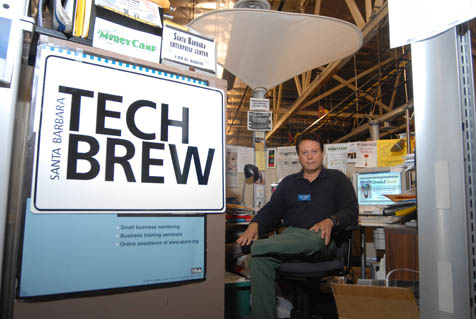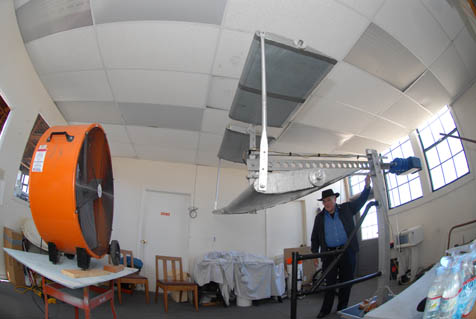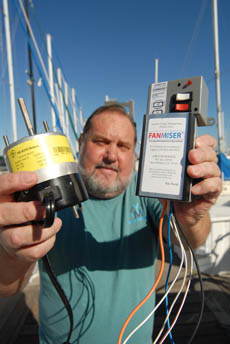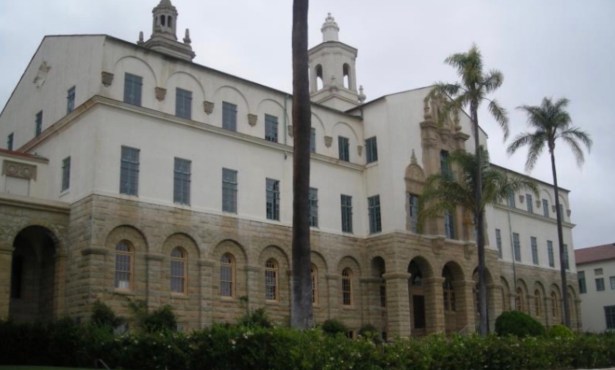Inventors Save Planet

Now that just about everybody but Exxon has finally admitted that global warming is a reality, the opportunity to make money is obvious. From the labs of multinational corporations to suburban garages, inventors all over the globe are trying to find ways to rescue the world and get rich doing it.
Santa Barbara, which likes to think of itself as the birthplace of the environmental movement, is holding its own pretty well in this contest. The array of astonishing inventions pouring out of UCSB now includes film-thin photovoltaic cells as well as super-efficient LED lights. In the world beyond academia as well there is a groundswell of green innovators, and people eager to cultivate them. Even before global warming became a household word, Larry Crandell, Santa Barbara’s long-reigning silver-tongued emcee for civic ftes and corporate roasts, was promulgating the notion that protecting the environment could be a for-profit venture-and not the exclusive province of tree-hugging Luddites who had taken vows of poverty. Crandell was promoting Essam Khashoggi’s dream of biodegradable styrofoam for fast-food restaurants more than a decade ago. True, it hasn’t come to full fruition yet, but the company, Santa Barbara-based Earthshell, is still slogging toward the goal. This perseverance is the trademark of dream chasers everywhere.
Today, the person who seems to be leading the orchestra of global salvation from his headquarters in downtown Santa Barbara is one Alan Arthur Tratner ( pictured above ). A native of Detroit, Tratner has been in the environmental movement ever since Union Oil’s Platform A blew out off the coast of Santa Barbara in 1969. A decade later, he was helping Governor Jerry “Moonbeam” Brown organize Sun Day in Los Angeles, a prototype of Earth Day, and for the following decade, he was introducing new products all over America with his EcoExpo traveling show. In 1987, Tratner took over the presidency of Inventors Workshop International, a post he still holds.
Tratner planted stakes in Santa Barbara in 1994, and now more than ever is encouraging the crowd to step right up to what he considers the greatest show on earth: human ingenuity put to the task of saving the planet. To hear Tratner tell it, he oversees a stable of inventors toiling away like the mad geniuses they are on projects that will soon solve global warming and every other environmental ill known to humanity. Whipping up excitement with the fast-paced patter of a sideshow barker, Tratner is eager to promote anybody with a green idea that he thinks can be turned into gold. “Enterprise,” he likes to say, “is the solution to the problems of the world.” And also, “We invented our way into this mess, and we can invent our way out of it.” Tratner would be perfect working at a carnival, agreed Crandell. “‘See the 2,000-pound man!’ That’s his style. His substance is that he works very hard.”
Indeed he does. With connections to every environmental, entrepreneurial, and inventors organization in the county, Tratner works day and night to hook up all his contacts from the past 40 years with each other. Last month, a couple hundred people convened at El Paseo Restaurant for the second inaugural meeting (after a hiatus) of Tech Brew, which Tratner describes as “the community’s premier high-tech business networking event.” It is one of several nonprofits headed by Tratner. Last year, he opened the Santa Maria Enterprise Center, a small business incubator whose offices are already full. Tratner’s plans for expanding it involve his pet project, Green2Gold, an incubator for sustainable products.
The results of Tratner’s networking can be impressive. Take Henry Hewitt, a retired attorney from Northern California who claims that his double-parabolic solar dish is 14 times as efficient as a trough, the next-best solar collector. He’s been working on this thing since before law school. Hewett woke up one morning to find that, thanks to his new friend Tratner’s efforts, his dishes will be helping to power the American Ethanol plant scheduled to start operating next year in Santa Maria. Jim Smallwood is another inventor Tratner has helped. Smallwood invented a “breakthrough” water filtering system, according to Tratner, and now he’s working with the U.S. Department of Commerce to help create potable water on the continent of Africa.
Tratner has a regular job: He directs the Santa Barbara Entrepreneurial Center at 402 E. Gutierrez Street, which is his headquarters and the headquarters of about five dozen other nonprofits and businesses. Tratner does a lot of his work in the conference room, helping with business plans, patent searches, licensing agreements, advertising, and capital. His particular passion is for mentoring innovators with a sustainable bent, and not only inventors. One recent afternoon, he was consulting via conference call with Debi Mori and CiCi Parsons, whose brilliant scheme could improve the lives of practically every Santa Barbaran-and tomorrow, the world. But for now it’s a secret.

Kitty Hawk All Over Again
The interior of the building is an enormous, skylit space filled with roomy cubicles, each one shaded by clever adjustable canopies. Along the perimeter are a number of enclosed offices, including that of Gene R. Kelley, one of Santa Barbara’s most remarkable inventors.
Kelley is a grandfatherly Southern gentleman given to wearing soft-brimmed black fedoras in the afternoon, and suspenders, traditions from his Virginia upbringing which is also evident in his light, charming accent. No newcomer to inventing, Kelley can claim credit for, among other things, the bumps on the side of the highway that wake you up if you drift too far to the right, called rumble strips. He is retired from Human Factor Engineering in Goleta, where he worked on projects as diverse as big-rig seats and flight controls for high-speed aircraft. Though Crandell was the first and biggest booster for Kelley’s new company, called Innovatech, Tratner is nonetheless pleased to promote him. It was easy to see why when Kelley explained his latest invention, a wind-harvesting machine which seems truly amazing.
Prop-driven turbines, developed in Carpinteria by wind-farm pioneer Jim Delson, are “magnificent engineering accomplishments,” said Kelley. However, they are less than five percent efficient in converting the available wind in a given “swept area” to useful energy. “That’s like a farmer planting 100 acres of corn and harvesting only five,” he said. By contrast, Kelley claims that his machine, the WindWing, is 40 to 60 percent efficient. His idea was to design “something almost like a Venetian blind that will provide more contact with the wind force.”
“Have you ever put your hand out the car window?” he asked. “You turn it and it goes up. That’s positive lift. Your turn it the other way and it goes down, that’s negative lift.” With a sensor attached to the wing system to adjust its angle of attack, the symmetrical wing will catch as much wind in one direction as the other. Utilizing a mechanical advantage, as they say in the trade, of 10 to one, the machine will convert 200 pounds of lift into one ton of useful force, Kelley said. He also invented an accumulator that stops the wing when it gets to the top or bottom and turns it around mechanically. The energy collected at that turnaround is accumulated and introduced back into the wing on its return trip. “I don’t know what the mechanical advantage is, but it could be 30 to one,” said Kelley. “We don’t know yet, we haven’t tested it, but we’re going to.” He also does not yet know how high they can stack the wings on a single pole.
One of the most thrilling moments of Kelley’s life was the maiden voyage, as it were, of the WindWing. He and two of his teammates-vice presidents Mike Remenih and David Buckalew-first trotted their prototype out of its Goleta hangar one day in early April of this year. They set it up outside and then went back in to fetch the fans to generate wind. “When we got back out, it was running all by itself,” he said. It turns out that the wing will start in winds as mild as five or six miles per hour, compared to the 12 or 16 miles per hour needed to get propeller-driven turbines spinning. It was Kitty Hawk all over again. “Mike got carried away,” Kelley recalled, “predicting that we would be planting an Innovatech flag on the moon.”
One great advantage of the WindWing over turbines is that it reduces the footprint of the wind farm, and it decentralizes production so that collection can take place nearer to the user, perhaps as near as a breezy backyard. Also, the contraption’s movement is so gentle that birds could perch safely on its wings, Kelley said, whereas propellers kill not just the large raptors that get all of the publicity, but bees and all kinds of small birds that simply become “a puddle of little feathers flying all over the place.” As a sideline, the WindWing can accommodate solar panels on its spacious surface.
That’s not all. The team found out that if they turn the WindWing upside down and put it in an aqueduct, it becomes the WaterWing, using the water’s weight and constant flow to create approximately 800 times the force available from the wind.
That’s one of the five basic ideas Kelley is working on. He can’t talk about the others yet.
Blowin’ in the Fridge
Not all the bright ideas come from engineers. Jack Joyner, whom Tratner is also promoting, lives and works in the Santa Barbara Harbor on a 25-foot Tollycraft adorned with two rusting bicycles, neither of them working at the moment. Joyner was in the refrigeration and air conditioning installation and repair business in Los Angeles for about 40 years, until he sold the company and came up to Santa Barbara, where he started California Abalone. Using a trick he learned from a marine scientist, Joyner and his partner, Bob Ratcliff, were nucleating pearls in some 300,000 abalone right off the coast, until El Ni±o hit and wiped them out in two days. Joyner decided to stay on the boat. His home/workshop is the very picture of live-aboard style, which is to say, cluttered. At 4:30 in the afternoon, old Star Trek reruns flickered on his scavenged RCA TV set while he explained the FanMiser, his most recent invention. It is a device that, when attached to a walk-in cooler or freezer, reduces energy use by an average of 25 percent.

Basically, the FanMiser slows a refrigerator’s fans way down when the compressor, which cools the fridge, clicks off. When the compressor kicks on again, the fans speed up. The FanMiser saves energy two ways: First, of course, because the motors spin the fans at fewer revolutions per minute. (The fans can’t be turned off completely or the top part of the fridge will get too warm, as warm air rises.) Second, the fans’ motors themselves are not re-heating the refrigerator as quickly, so the compressor needn’t turn on so frequently.
It’s so simple, you’d think somebody would have thought of it before, and indeed they did, but Joyner believes that he has built a better, more user-friendly mousetrap. The FanMiser’s potential customers include supermarkets and convenience stores, hospitals, floral shops, and restaurants. McDonald’s, Joyner said, with 32,000 stores worldwide, would be a coup. It spends $1 billion annually on energy, according to Joyner, and is now making every effort to save it, even slowing the speed of their blenders. “So you can see the potential,” he added. As for hospitals, according to Joyner, every one dollar they save on energy is equivalent to $20 in earned revenue because they don’t have to subtract the cost of employees, administration, and the like.
While the FanMiser is for existing refrigerators, Joyner has been working for two years with Gexpro (formerly General Electric Supply) on a second version for new refrigeration units, which, under 2006 California energy-saving standards, have to operate much more efficiently. Joyner’s been communicating with Gexpro to customize his design to their motor, which is due out next month, just as soon as it is approved by the Underwriters Lab. He believes that Gexpro is putting the finishing touches on a plan to market his unit with their new motor.
Every inventor has horror stories involving the violation of their intellectual property rights, and Joyner is no exception. One of his earlier inventions was a baby bottle retrofitted with Goretex on the bottom. It allowed air flow so that a baby was not vainly trying to suck from a vacuum-and consequently the baby would have fewer digestive difficulties-yet was constructed so that the bottle did not leak when you set it down. A major corporation which will not be named here was interested. Its representatives picked Joyner up in a limousine one day and discussed the idea of buying the patent. Instead, it simply stole and modified the idea, according to Joyner.
“When you invent something,” said Joyner, “you’ve got all of these people coming out of the woodwork to represent you, but most charge you $10,000 and don’t do anything. With Alan Tratner [in his role as facilitator of the Inventors Workshop], you have your own patent attorney” in the person of Richard Erbe, whom Joyner describes as “sharp as a knife.” Erbe gives a discount to workshop members, who meet on the first Wednesday of every month at the Eastside Library, and at other nearby locations including the Mark Taper Auditorium in Los Angeles one Saturday a month. Belonging to the group, for a low annual fee, also garners discounts from graphic artists, the assistance of fellow inventors, and “lots of information,” Joyner said.
Another Tratner vision soon to materialize is Phase II of the Santa Maria Enterprise Center. This is to be a second building, constructed by American Ethanol, where Tratner has visions of a Green2Gold headquarters close to fields of solar dishes and wind catchers, with workspace for a few dozen sustainably oriented innovators and laboratories where they can collaborate.
Meanwhile, all you South County innovators and wanna-be inventors and undiscovered geniuses who haven’t done so yet might want to mosey over to the Eastside Library to commune with others of your kind. The rest of us are counting on you to save the planet. You’ll probably find Tratner there, too: Intellectual property rights are his specialty.
4•1•1
Inventors Workshop meetings are held every first Wednesday at 6 p.m. at the Eastside Library (1102 E. Montecito St., 963-3727); every second Wednesday at 6 p.m. at the Santa Maria Enterprise Center (2nd Floor, 171 Town Center East, Santa Maria, 614-7070); and every third Wednesday at 6 p.m. at United Way of Ventura County (Ste. 100, 1317 Del Norte Rd., Camarillo, 485-6288). The Cashing in on Great Ideas series is held at the Mark Taper Auditorium in the L.A. Public Library (650 W. 5th St., Los Angeles, [213] 228-7210) once a month on Saturdays at 1 p.m. The next meeting is on August 11. For more information about Inventors Workshop International, call 879-1729.



